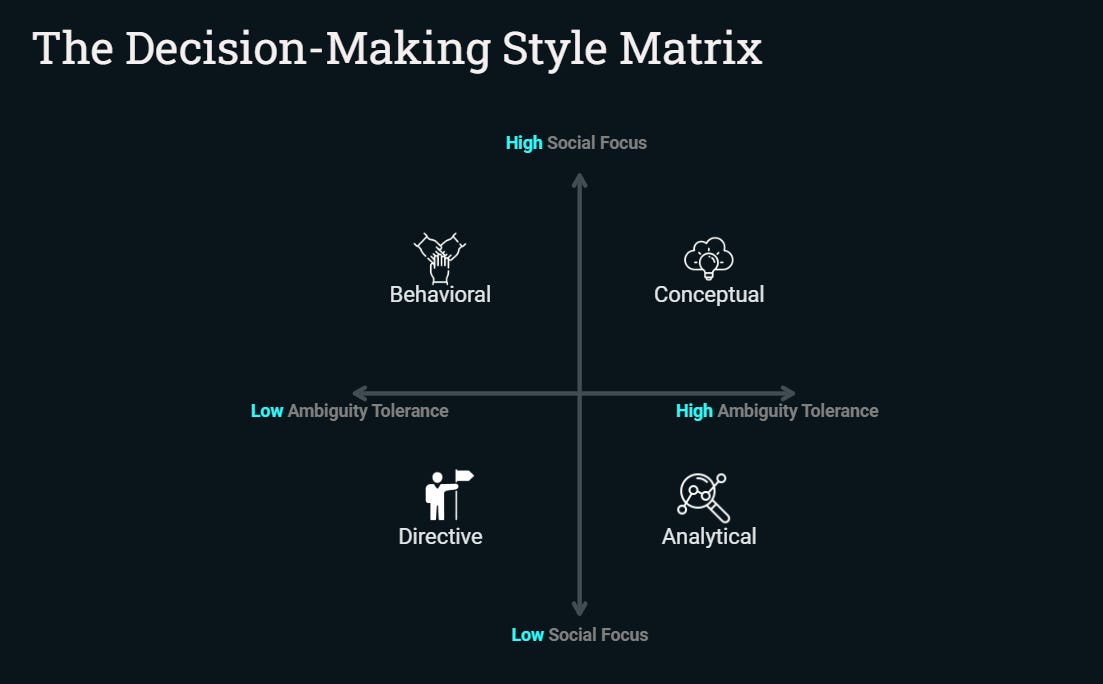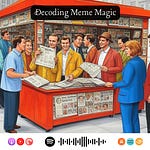In the latest episode of Marketing Science Lab, we take a deep dive into groundbreaking research on decision-making styles in creative agencies. This comprehensive literature review reveals how understanding and leveraging different decision-making approaches can significantly enhance job satisfaction, team dynamics, and overall creative output in marketing organizations.
The Four Pillars of Decision-Making in Creative Agencies
Our exploration unveils four primary decision-making styles that play crucial roles in creative agencies: behavioral, conceptual, directive, and analytical. Each style brings unique strengths and potential drawbacks that can significantly impact the success of creative projects.
Behavioral Decision-Making: The People-Centric Approach
The behavioral style focuses on people-oriented decision-making, emphasizing collaboration and team dynamics. This approach is particularly effective in managing team relationships and ensuring that all voices are heard.
Key benefits:
Enhances job satisfaction by fostering a supportive and inclusive work environment
Crucial for creative professionals who thrive on interpersonal interactions and feedback
Encourages open communication and cooperation
Reduces conflict and promotes a positive workplace culture
However, it's important to note that this style may lead to slower decision-making processes due to the emphasis on consensus and consideration of multiple perspectives.
Pros: Focuses on the well-being of team members and stakeholders, fostering a collaborative and supportive environment. This style is particularly effective in managing team dynamics and ensuring that all voices are heard (Sofo et al., 2013)
Cons: May lead to slower decision-making processes due to the emphasis on consensus and consideration of multiple perspectives (Basadur et al., 2014)
Contribution: Behavioral decision-makers can facilitate team cohesion and ensure that creative projects are inclusive and considerate of diverse viewpoints (Na et al., 2009)
Conceptual Decision-Making: Nurturing Innovation
The conceptual style involves a broad, long-term perspective, encouraging innovative thinking and creative problem-solving. This approach is particularly valuable for driving the creative vision of a project and inspiring teams to think outside the box.
Key aspects:
Aligns with intrinsic motivators of creative professionals (e.g., recognition, challenging projects)
Supports a culture of creativity by valuing diverse ideas
Fosters an environment where new concepts can be explored
While this style excels at identifying long-term opportunities, it may sometimes overlook practical constraints, leading to unrealistic project goals.
Pros: Encourages innovative thinking and the exploration of new ideas, which is essential in creative settings. This style is adept at identifying long-term opportunities and potential impacts (Čereška & Vasiliauskaitė, 2005)
Cons: Can be overly optimistic and may overlook practical constraints, leading to unrealistic project goals (Allwood & Selart, 2001)
Contribution: Conceptual decision-makers can drive the creative vision of a project, inspiring teams to think outside the box and explore novel solutions (Proctor, 2018)
Directive Decision-Making: Efficiency in Action
The directive style is characterized by a focus on efficiency and quick decision-making. This approach is beneficial in fast-paced creative environments, providing clear guidance and structure.
Notable features:
Enhances job satisfaction by reducing uncertainty
Helps in setting clear goals and expectations
Ensures projects stay on track and meet deadlines
However, this style may potentially stifle creativity and discourage input from team members if not balanced with other approaches.
Pros: Provides clear guidance and quick decision-making, which is beneficial in fast-paced environments. This style is effective in situations requiring decisive action and strong leadership (Allwood & Selart, 2010)
Cons: May stifle creativity and discourage input from team members, leading to a lack of diverse ideas (Brinkers, 1972)
Contribution: Directive decision-makers can ensure that projects stay on track and meet deadlines, providing the necessary structure and direction for creative endeavors (Na et al., 2009)
Analytical Decision-Making: Data-Driven Creativity
The analytical style emphasizes data-driven decision-making and thorough analysis. This approach ensures that decisions are well-informed and based on evidence, providing a sense of security and confidence in decision outcomes.
Key strengths:
Appeals to professionals who value logical reasoning and evidence-based approaches
Supports a culture of continuous improvement and learning
Effective in evaluating the feasibility and potential risks of creative projects
While this style brings rigor to decision-making, it can sometimes lead to analysis paralysis and slow down the creative process if not managed effectively.
Pros: Relies on data and logical reasoning, ensuring that decisions are well-informed and based on evidence. This style is effective in evaluating the feasibility and potential risks of creative projects (Čereška & Vasiliauskaitė, 2005)
Cons: Can be overly cautious and slow, potentially hindering the creative process and delaying project progress (Allwood & Selart, 2001)
Contribution: Analytical decision-makers can provide critical insights and assessments, helping to refine and optimize creative strategies (Proctor, 2018)
Integrating Decision-Making Styles for Maximum Impact
The real power lies in understanding and effectively integrating these four decision-making styles. By fostering an environment that values diverse decision-making approaches, agencies can enhance their adaptability and resilience, ultimately leading to more innovative and successful creative projects.
Benefits of a balanced approach:
Enhanced job satisfaction: Recognizing and valuing different decision-making styles creates an environment where all team members feel their contributions are appreciated.
Improved team dynamics: A balanced approach leads to more comprehensive and effective decision-making processes.
Increased creativity and innovation: The interplay between different styles can spark new ideas and approaches.
Better problem-solving: Combining analytical rigor with conceptual thinking and behavioral insights results in more robust solutions to complex marketing challenges.
Adaptability: Agencies that can flexibly apply different decision-making styles are better equipped to handle diverse clients and rapidly changing market conditions.
Practical Implementation for Marketing Teams
To leverage these insights, consider the following strategies:
Assess your team's decision-making profile: Conduct an audit to understand which styles are dominant and which might be underrepresented in your team.
Develop a balanced approach: Consciously incorporate elements from each style into your decision-making processes, especially during critical phases like campaign planning or strategy development.
Foster self-awareness: Encourage team members to recognize their own preferred styles and to appreciate the value of other approaches.
Create diverse teams: When assembling project teams, aim for a mix of decision-making styles to ensure a well-rounded approach.
Tailor communication: Adapt your communication style based on the decision-making preferences of team members or clients to improve understanding and buy-in.
Implement training programs: Develop workshops or training sessions to help team members understand and apply different decision-making styles effectively.
Establish a flexible decision-making framework: Create a process that allows for different styles to be utilized based on the nature of the project or challenge at hand.
By embracing this holistic approach to decision-making, marketing teams can unlock new levels of creativity, efficiency, and job satisfaction, ultimately leading to more impactful and successful campaigns.

Sources:
Allwood, C. M., & Selart, M. (2001).Decision making: Social and creative dimensions. https://doi.org/10.1007/978-94-015-9827-9
Basadur, M., Gelade, G. A., & Basadur, T. (2014). Creative Problem-Solving Process Styles, Cognitive Work Demands, and Organizational Adaptability:The Journal of Applied Behavioral Science. https://doi.org/10.1177/0021886313508433
Brinkers, H. S. (1972). Decision-making: creativity, judgment, and systems.
Mondroski, M. M., Reid, L. N., & Russell, J. T. (2012). Agency Creative Decision Making: A Decision Systems Analysis. Current Issues and Research in Advertising.
Mullaly, M. E. (2015).Exercising Agency: Decision Making and Project Initiation.
Na, W., Marshall, R., & Woodside, A. G. (2009). Decision system analysis of advertising agency decisions.Qualitative Market Research: An International Journal. https://doi.org/10.1108/13522750910948761
Proctor, T. (2018).Creative Problem Solving for Managers: Developing Skills for Decision Making and Innovation.
Sofo, F., Colapinto, C., Sofo, M., & Ammirato, S. (2013).Practical Application and the Emergence of ADM 3.0. https://doi.org/10.1007/978-1-4614-6708-3_4
Čereška, B., & Vasiliauskaitė, K. (2005). Application of the Theory of Decision-Making to Decisions about Creative Advertising Strategy. The Engineering Economics. https://doi.org/10.5755/J01.EE.45.5.11346












